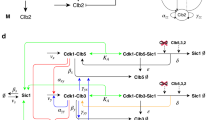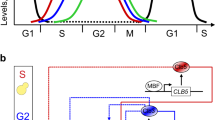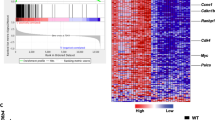Abstract
Despite the complexity and variety of biological oscillators, their core design invariably includes an essential negative feedback loop. In the Xenopus laevis embryonic cell cycle oscillator, this loop consists of the kinase cyclin B–Cdk1 and the ubiquitin ligase APC/CCdc20; active Cdk1 activates APC/CCdc20, which then brings about cyclin B degradation and inactivates Cdk1. Here we ask how this negative feedback loop functions quantitatively, with the aim of understanding what mechanisms keep the Cdk1–APC/CCdc20 system from settling into a stable steady state with intermediate levels of Cdk1 and APC/CCdc20 activity. We found that the system operates as a time-delayed, digital switch, with a time lag of ∼ 15 min between Cdk1 and APC/CCdc20 activation and a tremendously high degree of ultrasensitivity (nH≈17). Computational modelling shows how these attributes contribute to the generation of robust, clock-like oscillations. Principles uncovered here may also apply to other activator–repressor oscillators and help in designing robust synthetic clocks.
This is a preview of subscription content, access via your institution
Access options
Subscribe to this journal
Receive 12 print issues and online access
$209.00 per year
only $17.42 per issue
Buy this article
- Purchase on Springer Link
- Instant access to full article PDF
Prices may be subject to local taxes which are calculated during checkout





Similar content being viewed by others
References
Goldbeter, A. Biochemical Oscillations and Cellular Rhythms: The Molecular Bases of Periodic and Chaotic Behaviour (Cambridge Univ. Press, 1996).
Thomas, R. On the relation between the logical structure of systems and their ability to generate multiple steady states or sustained oscillations. Springer Ser. Synergetics 9, 180–193 (1981).
Becskei, A. & Serrano, L. Engineering stability in gene networks by autoregulation. Nature 405, 590–593 (2000).
Griffith, J. S. Mathematics of cellular control processes. I. Negative feedback to one gene. J. Theor. Biol. 20, 202–208 (1968).
Tyson, J. J. & Othmer, H. G. The dynamics of feedback control circuits in biochemical pathways. Prog. Theor. Biol. 5, 1–62 (1978).
Novak, B. & Tyson, J. J. Design principles of biochemical oscillators. Nat. Rev. Mol. Cell Biol. 9, 981–991 (2008).
Stricker, J., Cookson, S., Bennett, M., Tsimring, L. & Hasty, J. A fast, robust, and tunable synthetic gene oscillator. Nature 456, 516–519 (2008).
Tsai, T. Y. et al. Robust, tunable biological oscillations from interlinked positive and negative feedback loops. Science 321, 126–129 (2008).
Hara, K., Tydeman, P. & Kirschner, M. A cytoplasmic clock with the same periodas the division cycle in Xenopus eggs. Proc. Natl Acad. Sci. USA 77, 462–466 (1980).
Murray, A. W. & Kirschner, M. W. Dominoes and clocks: the union of two views of the cell cycle. Science 246, 614–621 (1989).
Pines, J. Cubism and the cell cycle: the many faces of the APC/C. Nat. Rev. Mol. Cell Biol. 12, 427–438 (2011).
King, R. W. et al. A 20S complex containing CDC27 and CDC16catalyzes the mitosis-specific conjugation of ubiquitin to cyclin B. Cell 81, 279–288 (1995).
Sha, W. et al. Hysteresis drives cell-cycle transitions in Xenopus laevis egg extracts. Proc. Natl Acad. Sci. USA 100, 975–980 (2003).
Pomerening, J. R., Sontag, E. D. & Ferrell, J. E. Jr Building a cell cycle oscillator: hysteresis and bistability in the activation of Cdc2. Nat. Cell Biol. 5, 346–351 (2003).
Pomerening, J. R., Kim, S. Y. & Ferrell, J. E. Jr Systems-level dissection of the cell-cycle oscillator: bypassing positive feedback produces damped oscillations. Cell 122, 565–578 (2005).
Felix, M. A., Labbe, J. C., Doree, M., Hunt, T. & Karsenti, E. Triggering of cyclin degradation in interphase extracts of amphibian eggs by cdc2 kinase. Nature 346, 379–382 (1990).
Kim, S. Y. & Ferrell, J. E. Jr Substrate competition as a source of ultrasensitivity in the inactivation of Wee1. Cell 128, 1133–1145 (2007).
Trunnell, N. B., Poon, A. C., Kim, S. Y. & Ferrell, J. E. Jr Ultrasensitivity in the regulation of Cdc25C by Cdk1. Mol. Cell 41, 263–274 (2011).
Mochida, S., Ikeo, S., Gannon, J. & Hunt, T. Regulated activity of PP2A-B55 delta is crucial for controlling entry into and exit from mitosis in Xenopus egg extracts. EMBO J. 28, 2777–2785 (2009).
Izawa, D. & Pines, J. How APC/C-Cdc20 changes its substrate specificity in mitosis. Nat. Cell Biol. 13, 223–233 (2011).
Minshull, J., Sun, H., Tonks, N. K. & Murray, A. W. A MAP kinase-dependent spindle assembly checkpoint in Xenopus egg extracts. Cell 79, 475–486 (1994).
Minshull, J., Golsteyn, R., Hill, C. S. & Hunt, T. The A- and B-type cyclin associated cdc2 kinases in Xenopus turn on and off at different times in the cell cycle. EMBO J. 9, 2865–2875 (1990).
Foe, I. T. et al. Ubiquitination of Cdc20 by the APC occurs through an intramolecular mechanism. Curr. Biol. 21, 1870–1877 (2011).
Strogatz, S. H. Nonlinear Dynamics and Chaos: With Applications to Physics, Biology, Chemistry, and Engineering (Westview Press, 1994).
Murray, A. W. & Kirschner, M. W. Cyclin synthesis drives the early embryonic cell cycle. Nature 339, 275–280 (1989).
Stern, B. & Nurse, P. A quantitative model for the cdc2 control of S phase and mitosis in fission yeast. Trends Gene. 12, 345–350 (1996).
Coudreuse, D. & Nurse, P. Driving the cell cycle with a minimal CDK control network. Nature 468, 1074–1079 (2010).
Oikonomou, C. & Cross, F. R. Rising cyclin-CDK levels order cell cycle events. PLoS One 6, e20788 (2011).
Gavet, O. & Pines, J. Progressive activation of CyclinB1–Cdk1 coordinates entry to mitosis. Dev. Cell 18, 533–543 (2010).
Georgi, A. B., Stukenberg, P. T. & Kirschner, M. W. Timing of events in mitosis. Curr. Biol. 12, 105–114 (2002).
Kim, S. Y., Song, E. J., Lee, K. J. & Ferrell, J. E. Jr Multisite M-phase phosphorylation of Xenopus Wee1A. Mol. Cell Biol. 25, 10580–10590 (2005).
Skotheim, J. M., Di Talia, S., Siggia, E. D. & Cross, F. R. Positive feedback of G1 cyclins ensures coherent cell cycle entry. Nature 454, 291–296 (2008).
Doncic, A., Falleur-Fettig, M. & Skotheim, J. M. Distinct interactions select and maintain a specific cell fate. Mol. Cell 43, 528–539 (2011).
Kimata, Y., Baxter, J. E., Fry, A. M. & Yamano, H. A role for the Fizzy/Cdc20 family of proteins in activation of the APC/C distinct from substrate recruitment. Mol. Cell 32, 576–583 (2008).
Solomon, M. J., Glotzer, M., Lee, T. H., Philippe, M. & Kirschner, M. W. Cyclin activation of p34cdc2. Cell 63, 1013–1024 (1990).
Nash, P. et al. Multi-site phosphorylation of a CDK inhibitor sets a threshold for the onset of S-phase. Nature 414, 514–521 (2001).
Smythe, C. & Newport, J. W. Systems for the study of nuclear assembly, DNA replication, and nuclear breakdown in Xenopus laevis egg extracts. Meth. Cell Biol. 35, 449–468 (1991).
Murray, A. W. Cell cycle extracts. Meth. Cell Biol. 36, 581–605 (1991).
Hagting, A. et al. Human securin proteolysis is controlled by the spindle checkpoint and reveals when the APC/C switches from activation by Cdc20 to Cdh1. J. Cell Biol. 157, 1125–1137 (2002).
Acknowledgements
We thank J. Chang and A. Poon for help obtaining purified Δ65-cyclin B1 and Cdk1AF proteins, S. Santos and J. Pomerening for cyclin B1–CFP and cyclin A2–YFP constructs, T. Tsai for sharing his findings on the effects of PD0166285 on Xenopus Wee1A and Myt1, R. Driscoll from the Cimprich laboratory for advice on freezing extracts, and G. Anderson, J. Chang, A. Moskaleva, T. Tsai and the rest of the Ferrell laboratory for scientific discussions and editorial suggestions. We also thank Pfizer for providing PD0166285. Q.Y. is an HHMI Fellow of the Damon Runyon Cancer Research Foundation (DRG-2081-11). This work was supported by the National Institutes of Health grant GM046383.
Author information
Authors and Affiliations
Contributions
Q.Y. carried out experiments and calculations, analysed data and helped write the paper. J.E.F. carried out calculations, analysed data and helped write the paper.
Corresponding author
Ethics declarations
Competing interests
The authors declare no competing financial interests.
Supplementary information
Supplementary Information
Supplementary Information (PDF 726 kb)
Supplementary Information
Supplementary Information (PDF 1130 kb)
Supplementary Table 1
Supplementary Information (XLS 32 kb)
Rights and permissions
About this article
Cite this article
Yang, Q., Ferrell, J. The Cdk1–APC/C cell cycle oscillator circuit functions as a time-delayed, ultrasensitive switch. Nat Cell Biol 15, 519–525 (2013). https://doi.org/10.1038/ncb2737
Received:
Accepted:
Published:
Issue Date:
DOI: https://doi.org/10.1038/ncb2737
This article is cited by
-
CDK1–cyclin-B1-induced kindlin degradation drives focal adhesion disassembly at mitotic entry
Nature Cell Biology (2022)
-
Crosstalk between Plk1, p53, cell cycle, and G2/M DNA damage checkpoint regulation in cancer: computational modeling and analysis
npj Systems Biology and Applications (2021)
-
Mechanisms for the temporal regulation of substrate ubiquitination by the anaphase-promoting complex/cyclosome
Cell Division (2019)
-
Systems and synthetic biology approaches in understanding biological oscillators
Quantitative Biology (2018)
-
A cdk1 gradient guides surface contraction waves in oocytes
Nature Communications (2017)



